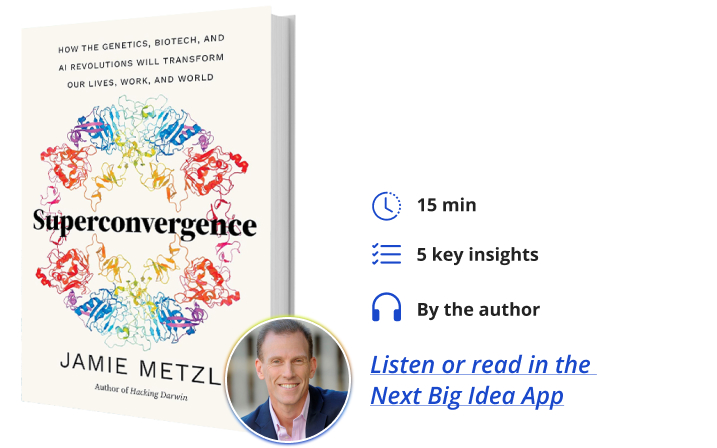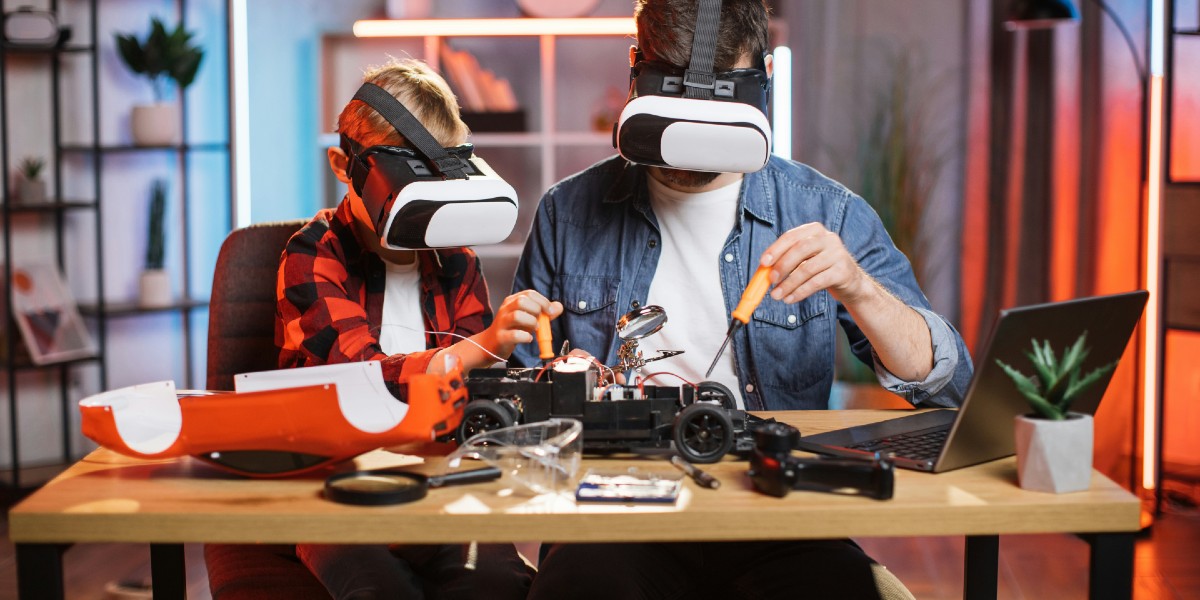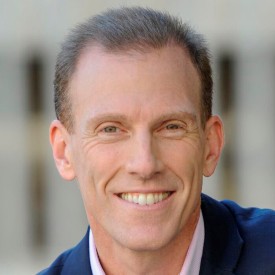Jamie Metzl is a leading technology and healthcare futurist and the founder and chair of OneShared.World. He is the author of Hacking Darwin: Genetic Engineering and the Future of Humanity and four other books and was a member of the World Health Organization expert advisory committee on human genome editing. Jamie previously served in the U.S. National Security Council, State Department, and Senate Foreign Relations Committee and with the United Nations in Cambodia. His work has been featured by most major media organizations around the world, including 60 Minutes, the New York Times, the Wall Street Journal, the Washington Post, Fox, CNN, ABC, NBC, CBS, the Times of London, Le Monde, and Paris Match. Academically, he is a graduate of Brown, Harvard, and Oxford.
Below, Jamie shares five key insights from his new book, Superconvergence: How the Genetics, Biotech, and AI Revolutions Will Transform our Lives, Work, and World. Listen to the audio version—read by Jamie himself—in the Next Big Idea App.

1. Our world is at the precipice of a radical and fundamental change.
Two of the biggest changes today are human-engineered intelligence and human-engineered life. Putting it another way, after nearly roughly 3.8 billion years of evolution, suddenly, one species has God-like powers. The drivers of this change are compounding and accelerating, with big implications for everyone. There are four times more people now than just a hundred years ago. We’re better educated and more literate. We’re so connected to each other that nobody needs to invent something already invented somewhere else. Every day, the baseline for innovation is reset, and the technologies are converging.
Every technology is embedded in every other technology. Agriculture and industrialization are embedded in the computer revolution. The computer revolution is embedded in the machine learning revolution. The machine learning revolution and AI are embedded in our ability to interrogate biological designs that have evolved over four billion years. Then, using those designs—like how plants distribute nutrients in leaves—we can design better computer chips that speed up everything. That’s the entire point of Superconvergence: acceleration. Because of that acceleration, when we think about change, we can’t index the rate of change based on our historical experience of it.
2. This change is not abstract or theoretical.
This change will show up in key areas of our lives. In healthcare, we’re moving away from a world of generalized healthcare based on population averages, meaning a system in which we’re not really treated as individuals. That was a great way to do healthcare in the past, but now we’re moving toward a world where we have personalized treatment based on who we are on a molecular level. To do that, we will need a lot more data about ourselves—and we’re already starting to see that. In the future, it’s not just that we will all have our whole genomes sequenced as a foundation of our electronic health records. All kinds of biological information will be stored in massive data sets.
The big formula of this revolution is that if you have more data, better algorithms, and more computing power, you can decipher patterns in vast data pools far beyond what our unaided brains can do. This will make healthcare much more precise and tailored toward who we individually are. We’re already seeing this transition in the creation of personalized drugs, so-called pharmacogenomics or gene therapy. An incredible woman I write about, Victoria Gray, is one of the first people to be treated with gene therapy to essentially cure her sickle cell disease and fundamentally transform her life.
“The big formula of this revolution is that if you have more data, better algorithms, and more computing power, you can decipher patterns in vast data pools far beyond what our unaided brains can do.”
The next step in the evolution of healthcare will be a transition from precision to predictive and preventive care, because bigger data pools will allow us to decipher patterns repeatedly. We will recognize that our healthcare exists within a range of possibilities, and the goal will be to optimize our lives in that upper range of possibilities so that in specific cases and areas, we can move beyond our innate biology.
The same drivers will also transform agriculture. Most of us are here because of modern agriculture. Our population numbers have increased so radically over the last 10,000 years, particularly over the last 100 years, because of advances in agriculture. But now we have an embarrassment of riches. We’ve been so successful that industrial agriculture itself is creating a lot of problems. We’re growing from 8 billion to 10 billion people, and if we try scaling up agriculture as it is to feed those mouths, we’re going to wipe out all of our wild spaces and inflict immeasurable harm to the environment. Instead of expanding agriculture, we have to increase current agriculture’s productivity—tools of advanced biotechnology will help. I know biotech in agriculture is scary to many people. GMOs scare people. But we should think of all agriculture as an aggressive form of biotechnology. Even the agriculture that indigenous people engaged in was aggressive biotechnology.
Advanced materials are another transformative application. Spider silk is one example. It’s stronger than Kevlar and stretchier than our stretchiest elastics, but it’s hard to grow naturally. We can’t have communities of spiders making silk like we have silkworms because spiders are cannibals and would eat each other. Fortunately, we now have the tools of synthetic biology, whether it’s to get E. coli bacteria to generate spider silk, to get silkworms to generate spider silk, or to get goats to produce it in their milk. New models are changing the way we extract natural resources.
Another exciting application is data storage. DNA is the greatest data storage mechanism in history. All of our electronic records today are on magnetic tapes that can last maybe 30 to 50 years. So, we have to keep copying them over and over. We’re creating more data every two years than in all of human history before those two years, so copying the data is a big job. But DNA can store data in the right conditions for up to five million years.
3. These changes have the potential to help us enormously in fundamental ways.
With today’s frontiers of science, we will be able to get the resources to live longer, healthier, more robust lives and build a sustainable future for everybody. These changes can lead to a positive story.
4. If we’re not careful, these changes can cause fundamental harm.
But things could go terribly wrong if we’re not careful—and even if we are. I was a member of the World Health Organization Expert Advisory Committee on Human Genome Editing after the Chinese CRISPR babies were born. That was an incredible abuse. For the last four and a half years, I have been at the center of the debate over COVID origins. COVID origins, in my view, are very likely connected to a research-related incident: not intentional, an accident. We’re at the beginning of an age of synthetic biology, where we have incredible tools that could be used for good but could also be used in harmful ways.
“However, if we’re not careful, we could also inadvertently crash ecosystems.”
We have the new technologies of gene drives, where we can basically eradicate malaria by weaponizing the tools of the genetics revolution. However, if we’re not careful, we could also inadvertently crash ecosystems. There’s a balance. If we’re wildly optimistic, that’s dangerous. If we’re wildly pessimistic, that’s also dangerous.
5. Things we can do now to optimize the benefits and minimize the harms.
There’s a quote by Thoreau that I’ve loved since childhood: “If we’ve built castles in the air, our work need not be lost, that is where they should be. Now put the foundations under them.” So, the question is, how do we do it using another metaphor?
It’s celestial guidance. When we’re sailing, we don’t know exactly how we’re going to get where we’re going, but we have a destination and recognize that we’ll need to tack and respond to the wind and other conditions to get there. That’s why I say that this isn’t a conversation about technology; it’s a conversation about the values we use to guide increasingly powerful technologies.
I’ve developed a framework for how we can think about guiding this technology. It’s a “pyramid of efforts” we can work on, starting from the ground up. At the level of individual and public education: articulating core principles, national regulation, broad scale governance. In our WHO report, we talked about “governance” as including but going beyond what government does. UN reform is essential, but we also need to think differently about how our world is organized.
The basic idea of the movement I founded, the Global Interdependence Movement OneShared.World, is that our biggest problems—pandemics, climate change, nuclear weapons, technology governance, etc.—are global and common, but we don’t have a framework for addressing that entire category of challenges. That’s what OneShared.World is about. We’re each going to have to imagine the world we want to inhabit.
Our technologies are growing up. We are seeing AI systems get more powerful by the day. With the release of the OpenAI ChatGPT-4o, AI systems suddenly developed eyes and ears. We’re sticking little sense organs onto AI, almost like Mr. Potato Head. It’s very, very early, but there was a time when our ancestors, these very simple organisms, were first able to differentiate light. This sense was a precursor to our eyes. There’s now a race pushing these technologies and capabilities forward. We can’t and shouldn’t leave these advancements to experts alone. This is a conversation about the future of our species, and we each have a role to play in guiding that future. This book is my effort to help bring people into that process.
Here are three things that everyone can do:
- Learn, learn, learn. We all regularly learn the things that are in our direct line of sight, but there’s so much change happening that we need to do more. We should each spend around two hours a day learning things that are not in our direct line of sight. Let curiosity be your guide while exploring adjacent spaces.
- Re-prioritize tasks. AI won’t replace humans, but every job will change. Every job is made up of tasks, and if one of these subtasks ten years from now will be an essentially human task, then spend a lot of your time doing that. If it’s going to be an AI task, then let the AI do that. If it’s going to be a hybrid task, we need to dynamically negotiate what that is.
- Values, values, values. Humans have always had new technologies. If we think this is about technology and don’t recognize that this is about how our core values are realized in a new domain, we will be in a lot of trouble. Think through your values.
To listen to the audio version read by author Jamie Metzl, download the Next Big Idea App today:































